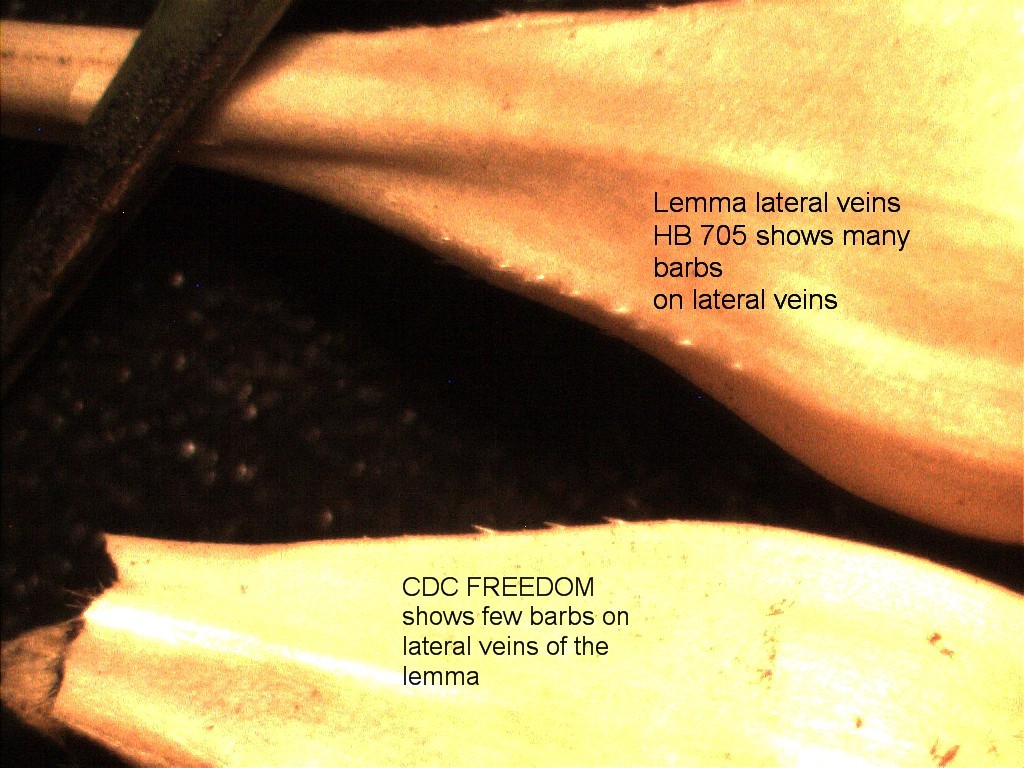Taylor
| Denomination: | 'Taylor' |
|---|---|
| Previously Proposed Denomination: | 'HB705' |
| Botanical Name: | Hordeum vulgare |
| Applicant/Holder: |
Agriculture & Agri-Food Canada, Brandon Brandon Research Centre, 18th St. & Grand Valley R P.O. Box 1000A, R.R. #3 Brandon, Manitoba R7A 5Y3 Canada |
| Breeder: |
Bill Legge, Agriculture & Agri-Food Canada, Brandon, Manitoba |
| Agent in Canada: |
Agriculture & Agri-Food Canada Office of Intellectual Property and Commercialization c/o Shannon Whyte 107 Science Place Saskatoon, Saskatchewan S7N 0X2 Canada Tel: (204) 999-9887 |
| Application Date: | 2009-04-23 |
| Application Number: | 09-6630 |
| Grant of Rights Date: | 2011-11-17 |
| Certificate Number: | 4215 |
| Date rights surrendered: | 2020-10-26 |
Variety Description
Varieties used for comparison: 'CDC Freedom' and 'CDC McGwire'
Summary: The plant growth habit of 'Taylor' is erect to semi-erect at tillering whereas it is intermediate in 'CDC McGwire'. The frequency of plants with recurved flag leaves is low in 'Taylor' whereas it is high in 'CDC McGwire'. The plant height of 'Taylor' is taller than that of both reference varieties. The lemma awns of 'Taylor' are semi-smooth whereas they are rough on 'CDC McGwire'. The rachilla hairs of 'Taylor' are long whereas they are short to long on both reference varieties. There is strong spiculation of the inner lateral nerves of the dorsal side of the lemma of 'Taylor' whereas it is medium on 'CDC Freedom' and absent or very weak on 'CDC McGwire'.
Description:
PLANT: two row, spring feed and malting barley, erect to semi-erect growth habit at tillering, absent or very sparse pubescence on the lower leaf sheaths
FLAG LEAF: low frequency of plants with recurved flag leafs, absent or very weak pubescence on blade
FLAG LEAF SHEATH: strong to very strong glaucosity, absent or very weak pubescence
AURICLES: medium intensity of anthocyanin colouration, absent or very weak pubescence on the margins
SPIKE: emerges mid-season, very weak glaucosity, semi-erect to horizontal attitude, v-shaped open collar, parallel shape, medium density, parallel to weakly divergent to divergent attitude of sterile spikelet, glume and awn length of the median spikelet is longer than the grain
FIRST SEGMENT OF RACHIS: short, absent or very weak to very strong curvature
LEMMA AWNS: strong intensity of anthocyanin colouration of the tips, longer than length of spike, semi-smooth spiculations on margins
KERNEL: absent or very weak intensity of anthocyanin colouration of nerves of the lemma at beginning of ripening, whitish aleurone layer, long rachilla hairs, husk absent, strong spiculation of inner lateral nerves of dorsal side of lemma, no hairiness of ventral furrow, clasping disposition of lodicules, horseshoe and incomplete horseshoe shape basal markings
AGRONOMY: fair to good resistance to lodging, fair malting quality
DISEASE REACTION: moderately susceptible to common root rot (Cochliobolus sativus, Fusarium spp.) and spot blotch (Cochliobolus sativus), moderately susceptible to moderately resistant to Net blotch (Pyrenophora teres), Stem rust (Puccinia graminis), Covered smut (Ustilago hordie) and False loose smut, Black semi-loose smut (Ustilago nigra), susceptible to Septoria speckled leaf blotch (Septoria passerinii) and Scald (Rhynchosporium secalis), resistant to moderately resistant to Fusarium head blight (Scab) (Fusarium graminearum); perfect state (Gibberella zeae) and resistant to True loose smut (Ustilago nuda)
Origin & Breeding History: 'Taylor' (experimental designation 'HB705') is a doubled haploid barley line developed from the cross 'CDC Freedom'/'Rivers' conducted at the Agriculture and Agri-Food Canada Brandon Research Centre, Brandon, Manitoba. The original cross was made in the greenhouse in 2000 with 2 seeds of the F1 generation being planted in each of 5 pots in July 2001. Spikes were collected for doubled haploid production using in vitro selection with Fusarium mycotoxins applied during the anther culture step and embryos developed. Numerous doubled haploid plants resulted, one of which became BM0058DT-5-1, which was transplanted in the greenhouse, grown to maturity and harvested in April 2002. In 2002, BM0058DT-5-1 was planted out in the nursery, inoculated with three different isolates of Fusarium graminearum, visually evaluated, hand harvested, analyzed for deoxynivalenol content and bulked in a winter nursery in Leeston, New Zealand the following winter. In spring 2003, BM0058DT-5-1 was planted out in Brandon and evaluated for various agronomic, disease resistance and quality characteristics. BM0058DT-5-1 was advanced to preliminary yield tests and further evaluated during the 2004 and 2005 growing season. From 2006 to 2008, BM0058DT-5-1 was evaluated in the Western Cooperative Hulless Barley Registration Test as HB705. Further evaluation of malting quality potential in multi-site trials were undertaken from 2007-2008.
Tests & Trials: Tests and trials for 'Taylor' were conducted in Brandon, Manitoba during the summers of 2009 and 2010. The trials consisted of 4 replicates of each variety arranged in complete randomized block design. Each plot measured approximately 4 metres long x 1 metre wide spaced approximately 0.5 metres apart with a row spacing of 0.18 metres. Measured characteristics were based on approximately 20 measurements per variety per year.
Comparison tables for 'Taylor' with reference varieties 'CDC Freedom' and 'CDC McGwire'
Plant height, including awns (cm)
| 'Taylor' | 'CDC Freedom' | 'CDC McGwire' | |
|---|---|---|---|
| mean 2009 | 65.8 | 57.3 | 60.5 |
| std. deviation | 3.3 | 3.5 | 4.9 |
| mean 2010 | 83.3 | 69.3 | 75.8 |
| std. deviation | 7.1 | 6.5 | 3.5 |
Spike length, excluding awns (cm)
| 'Taylor' | 'CDC Freedom' | 'CDC McGwire' | |
|---|---|---|---|
| mean 2009 | 12.3 | 12.0 | 11.6 |
| std. deviation | 0.9 | 1.8 | 1.8 |
| mean 2010 | 9.5 | 9.5 | 8.6 |
| std. deviation | 1.4 | 1.2 | 0.9 |
Click on image for larger view

Barley: 'Taylor' (top) with reference variety 'CDC Freedom' (bottom)
Click on image for larger view

Barley: 'Taylor' (top) with reference variety 'CDC McGwire' (bottom)
- Date modified: